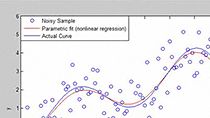What Is Smoothing?
Smoothing algorithms are often used to remove periodic components from a data set while preserving long term trends. For example, time-series data that is sampled once a month often exhibits seasonal fluctuations. A 12-month moving average filter will remove the seasonal component while preserving the long-term trend.
Alternatively, smoothing algorithms can be used to generate a descriptive model for exploratory data analysis. This technique is frequently used when it is impractical to specify a parameter model that describes the relationship between a set of variables.
Signal or time-series smoothing techniques are used in a range of disciplines including signal processing, system identification, statistics, and econometrics.
Common smoothing algorithms include:
- LOWESS and LOESS: Nonparametric smoothing methods using local regression models
- Kernel smoothing: Nonparametric approach to modeling a smooth distribution function
- Smoothing splines: Nonparametric approach for curve fitting
- Autoregressive moving average (ARMA) filter: Filter used when data exhibits serial autocorrelation
- Hodrick-Prescott filter: Filter used to smooth econometric time series by extracting the seasonal components
- Savitzky–Golay smoothing filter: Filter used when a signal has high-frequency information that should be retained
- Butterworth filter: Filter used in signal processing to remove high-frequency noise
For more information on smoothing, please see Statistics and Machine Learning Toolbox™, Curve Fitting Toolbox™, Econometrics Toolbox™, System Identification Toolbox™, and Signal Processing Toolbox™.
Examples and How To
Software Reference
See also: random number, machine learning, data analysis, mathematical modeling, time series regression, kalman filter, smoothing videos, probability distributions, process capability
